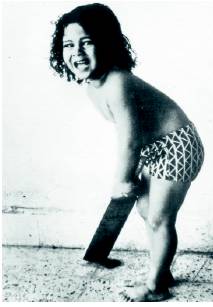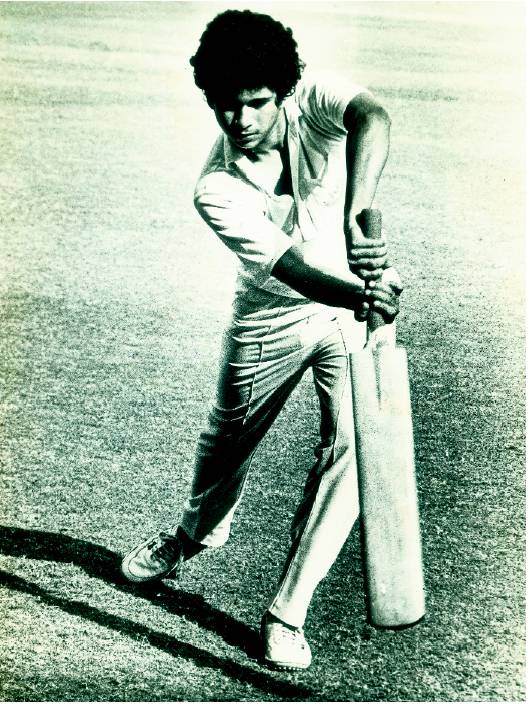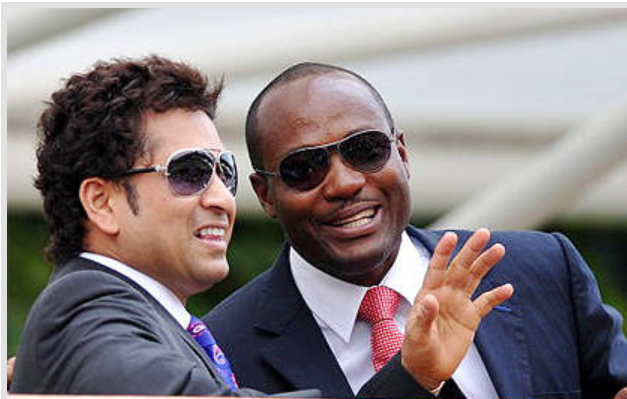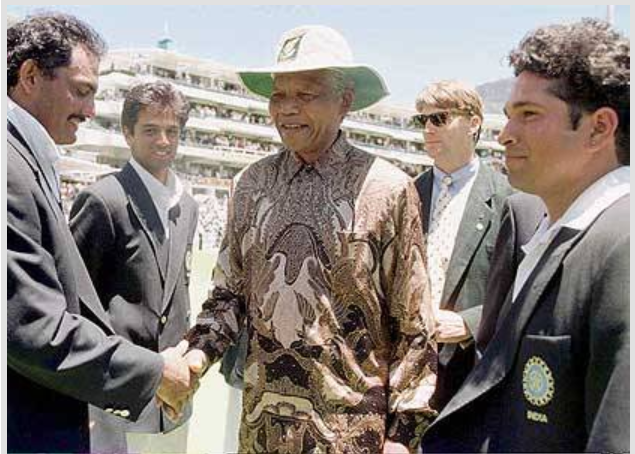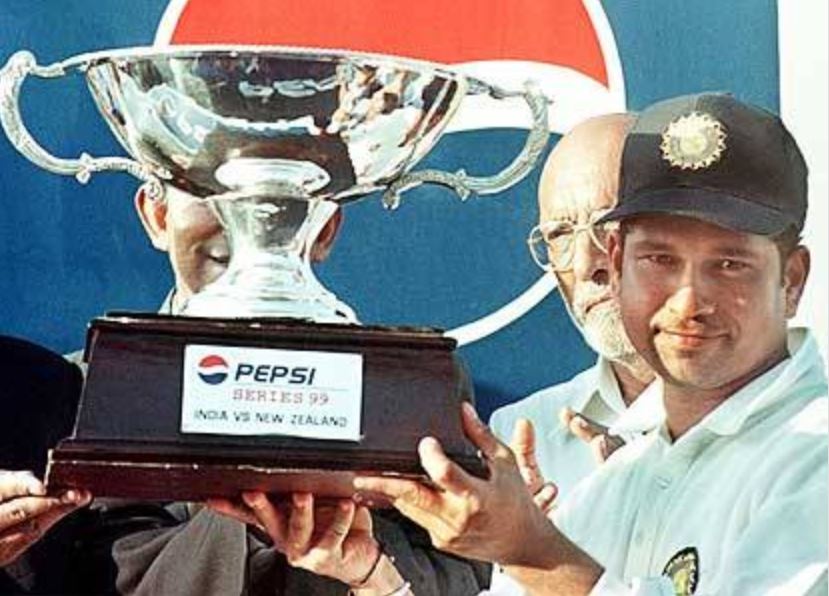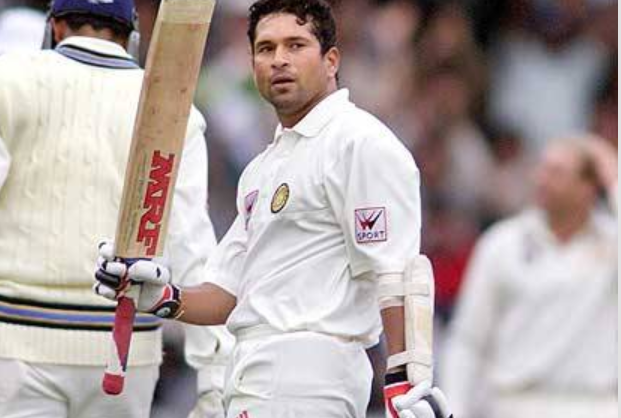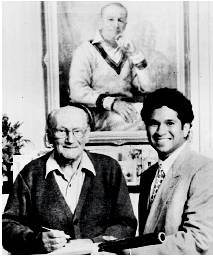Sachin Tendulkar 1: A timeline
This is a collection of articles archived for the excellence of their content. Readers will be able to edit existing articles and post new articles directly |
Photographs, including those credited to AFP are from the archives of The Times of India
Contents |
Timeline
IANS | Oct 10, 2013
Timeline of Sachin Tendulkar's cricketing achievements
Master blaster Sachin Tendulkar made his Test debut in Karachi against Pakistan at the age of 16.
A timeline of Sachin Tendulkar's 24-year-old illustrious career:
Feb 23-25, 1988: Tendulkar (14) and Vinod Kambli (16) compile a 664-run unbroken partnership for Shardashram Vidya Mandir against St Xavier's at Azad Maidan, Mumbai. Kambli remains unbeaten on 349 not out and Tendulkar scores 326 not out. It remains the highest partnership recorded in any form of cricket, until in November 2006.
Dec 11, 1988: Makes first-class debut at the age of 15 and scores an unbeaten century against Gujarat at the Wankhede Stadium. Becomes Youngest Indian to make a hundred on first-class debut.
Nov 15, 1989: Makes his Test debut in Karachi against Pakistan at the age of 16. Makes 15 on debut.
Dec 14, 1989: Suffers a bloody nose in the last Test in Sialkot after being hit by Waqar Younis. Makes 57 in the innings.
August 14, 1990: At the age of 17 years and 112 days, becomes the then second-youngest to score a Test century. He scores 119 not out against England at Old Trafford which helped India to get a draw.
April, 1992: Signs up for Yorkshire and becomes the first overseas signing for the English county.
Nov 27-28, 1992: Becomes the youngest player to score 1000 Test runs at the age of 19 years and 217 days after he scores 111 in India's 227 in Johannesburg.
Feb 11-12, 1993: Gets his first Test century (165) at home against England.
Nov 24, 1993: The world saw the first glimpse of Tendulkar as a match-winning bowler. Bowls India to sensational last-ball win against South Africa in the Hero Cup semi-final. South Africa needing six runs to win off the last over, Tendulkar gave them just three, and India a victory.
March 27, 1994: Opens the innings for the first time in an ODI against the New Zealand. Scores 82 off 49 balls.
October 1995: Becomes the richest cricketer in the world after he signs up a five-year contract worth Rs.31.5 crore with WorldTel.
Feb-March, 1996: Plays his first World Cup at home and scores 523 runs at an average 87.16 and becomes the highest scorer.
Aug 8, 1996: Becomes the Indian captain at the age of 23.
Jan 2, 1998: Sacked from captaincy after a 15-month stint during which India won just three of 17 Tests.
Feb-March, 1998: In the best of his form against Australia in a home Test series and also gets his maiden double hundred. He also scored two hundreds and a fifty in the three-Test series that India won 2-1.
July 28, 1999: Gets back his captaincy after Mohammad Azharuddin is sacked for India's failure to reach the semi-finals of the World Cup in England.
March 20, 2001: Scores a thrilling century in the deciding Test in Chennai and denies Australia the "final frontier".
March 31, 2001: Becomes the first payer to score 10,000 runs in ODIs en route to his 139 against Australia in Indore.
Nov 19, 2001: Fined by match referee Mike Denness for ball tampering. The decision was later overturned after an outcry by the Indian cricket board.
Aug 22-23, 2002: Surpassed Don Bradman's tally of 29 Test centuries. Misses double-century by seven at Headingley, but India win by an innings and 46 runs.
February-March, 2003: Scores 673 runs at 61.18 in the World Cup and also takes India to sniffing distance of winning the crown. His 98 against Pakistan was one of the best knocks played by Indians at World Cup. Australia are the champions, but Tendulkar is named the Man of the Series.
Aug, 2003: Is presented with a Ferrari 360 Modena for going past Bradman's 29 Test centuries.
Jan 2-4, 2004: Scores 241 in Sydney, one of his best, even as Australia manage to hold on for a draw, and the series ends 1-1.
Aug, 2004: Suffers from tennis elbow during the Videocon Cup in Holland. Misses the Champions Trophy in England, and then the first two home Tests against Australia.
March 16, 2005: Scores 52 against Pakistan and becomes the fifth man to score 10,000 Test runs.
May, 2005: Goes for the surgery for the tennis elbow.
Dec 10, 2005: Becomes the highest centurion in Test cricket as he overtakes Sunil Gavaskar's 34 en route to his 109 against Sri Lanka in Delhi.
March 19, 2006: Is booed at the Wankhede Stadium after he was dismissed for duck in 33 minutes against England in Mumbai.
March, 2006: Again goes under the knife. This time for surgery on his right shoulder in England.
May, 2007: For the first time in his career, Tendulkar is rested for the three-ODI series in Bangladesh.
Jan 4, 2008: Scores an unbeaten 154, against a major Test playing nation in two years and 19 Tests, against Australia at the Sydney Cricket Ground.
March 2, 2008: Sachin scores his first ODI century in Australia, in first of the CB Series final.
Oct 17, 2008: Surpasses Brian Lara's record of most Test runs against Australia at Mohali.
Nov 5, 2009: Gets to 17,000 runs during his 175 off 141 balls in a 351-run chase against Australia in Hyderabad. India fell short by 19 runs.
Feb 24, 2010: Becomes the first player in the history of the game to score 200 in a single innings in a one-day international. He took 147 deliveries to power India to 401 and a 153-run win against South Africa.
Oct 2010: Tendulkar bags his first ICC award, the Sir Garfield Sobers Trophy.
Dec 19, 2010: Gets his 50th Test hundred against a difficult South African attack in Centurion.
April 2, 2011: Realises his childhood dream of winning the World Cup that too at his home town of Mumbai and at the Wankhede. India beat Sri Lanka to win the World Cup for the second time.
March 16, 2012: Gets the 100th international century, scoring 114 in an Asia Cup match against Bangladesh in Mirpur. But India lost the match. The century came after 34 innings and more than a year after scoring his 99th international hundred.
Dec 23, 2012: Just minutes before the selectors were set to name the squad for the ODI series against Pakistan, Tendulkar announces his retirement from the format. Tendulkar finished with 18,426 ODI runs and 49 hundreds, well clear of any other batsman.
Oct 10, 2013: Tendulkar announces his retirement from Test cricket.
The Making Of A Master
BOY WONDER (1989)
Stories about his phenomenal talent and ability to play the best of strokes even before he turned 15 had already reached every cricket lover in the country, thanks to Mumbai's cricketing grapevine. So when he showed the typical teenage bravado while carting Pakistan leg-spinners Abdul Qadir and Mushtaq Ahmed in a 20-over friendly one-dayer in Peshawar and showed amazing power for a young boy while lofting the cricket ball, the world finally saw why Sachin Tendulkar was the most talked about 16-year-old in the world. While Peshawar saw the aggressive side of Tendulkar, the Test series saw his defensive side. His fifties in Faisalabad and Sialkot on greenish tracks were illustrative of his grit and temperament. That greatness was going to descend on him became obvious after he scored his maiden Test century in Old Trafford, Manchester, in what was a match-saving effort on a difficult fifth-day pitch.
CHARMING THE DON (1992)
Perhaps it was the first time the world saw what a punch off the back foot meant. On the bouncy pitches of Australia, he looked completely at ease and stroked wonderful centuries in Sydney and Perth. The time he got to play his strokes was the talk of the world. Seldom has an 18-year-old batted with such authority in alien conditions and that tour was the start of Tendulkar's love affair with the Australian bowling and pitches.
ONE-DAY SUPERSTAR (1994)
While he was a reasonably successful player in ODIs, he didn't quite get the big scores regularly as a result of batting too low in the line-up. An injury to Navjot Sidhu just before the second ODI in Auckland meant that Tendulkar went out to open and his 82 in 49 balls started another chapter. The field restrictions and his ability to clear the ball with ease, thanks to his incredible power and ability to pick up length early, meant that Tendulkar's address in the batting lineup in ODIs had permanently changed. The one stroke that regularly comes to mind is the pick up shot over mid-wicket where he cleared his front leg and used his wrists to send the ball to the fence.
PRESSURES OF CAPTAINCY (1996-1997)
After being named captain, he felt the pressure of carrying the team on his shoulders and cut out some of the strokes from his game. The strokes that went away were the lofted inside out shot over extra cover which he played regularly against the left-arm-spinners. He seldom stepped out to the spinners and that is why he often was perturbed by the left-arm-over spin angle.
GLORIOUS YEAR (1998)
The moment the captaincy was taken away from him, he got the freedom to play all the strokes again. Out came the lofted stroke, the slog sweep from the rough against Shane Warne, the lofted stroke over the bowler's head which he played almost entirely with the top hand. It was his most productive year in cricket. The free approach saw him slam four Test hundreds and nine ODI tons, earning him praise even from the great Don Bradman.
MILESTONES & HEARTBREAKS (1999-2007)
The most tumultuous phase of his career was also, in parts, the most enervating. A heartbreaking 136, played with an injured back against Pakistan in Chennai in a Test which India lost by 13 runs, was followed by another unremarkable stint as captain before he finally found himself part of a team with the talent and gumption to take on stronger opposition. As India blossomed under Sourav Ganguly, Sachin became the first player to score 10,000 runs in ODIs, sizzled in the 2003 World Cup only to see India lose in the final, overcame a career-threatening tennis elbow injury and scored a gritty 241* in Sydney in 2003-04. Also had a shoulder operation in 2006.
CONSISTENCY PERSONIFIED (2008-2012)
Refashioned himself into a less flamboyant but hugely consistent run-machine following India's disastrous 2007 World Cup sojourn and the exit of coach Greg Chappell. Scored an unbeaten, masterful 154 in Sydney, his first century in more than two years and 19 Tests against opposition other Bangladesh. Followed it up by his first ODI century in Australia in the CB Series before breaking Brian Lara's record of most Test runs in Mohali, all in 2008. Scored the first ODI double century in 2010 before realizing his dream of being part of a World Cup-winning squad in 2011.
Sachin's 20 glorious years
Sachin was picked by Mumbai captain Dilip Vengsarkar after seeing him negotiate Kapil Dev in the nets and was selected for the tour of Pakistan next year.
Sachin played his first Test match against Pakistan in Karachi in 1989 aged just 16.
Sachin Tendulkar made his maiden Test century, an unbeaten 119, against England at Old Trafford in 1990. He was the second youngest cricketer to do so at the age of 17 years 112 days. (
TENDULKAR IN TESTS
Most centuries (51). Highest run-aggregate - 15,837 at an average of 53.86 in 198 matches. Most centuries on foreign soil (29 in 106 Tests). Most international centuries (100; 51 in Tests and 49 in ODIs), 29 more than Ricky Ponting (71). Scored 150-plus more than 20 times, a world record. World record of 11 scores of 150-plus runs overseas. Most runs overseas — 8705 (ave.54.74) — in 106 Tests. Six innings of 200 or more, sharing an Indian record with Virender Sehwag.
70 Tests in a winning cause - the most by a player from the subcontinent. Averaged 62.36 in those Tests.
Completed a hundred with a six 6 times - another world record.
Registered 7 hundreds in a calendar year (2010), an Indian record.
Completed 1000 runs in a calendar year 6 times - a record.
Recorded 11 hundreds against Australia, the most by a player from the subcontinent.
Shares 20 century stands with Rahul Dravid, a world record for most century partnerships with one player.
Shares 18 double century stands - an Indian record and the second highest overall, next only to Kallis (20).
14 Man of the Match awards is the most by an Indian record.
With 5 Man of the Series awards, he shares an Indian record with Virender Sehwag.
Shares a record with Brian Lara and Kumar Sangakkara for reaching 10,000 runs in least number of innings (195).
Shares a record for reaching 12,000 runs in least number of innings (247) with Ricky Ponting.
Holds a record for reaching 13,000 runs in least number of innings (266).
Has appeared in 198 Tests, the most in Test annals.
Only player to have recorded 2000 fours (2044), apart from 69 sixes.
Managed 1,000 runs or more against seven opponents, sharing a world record with Rahul Dravid.
Memorable matches
Thank you for the memories, Master
While Sachin Tendulkar has provided some glorious moments for Indian cricket, there are some that are unforgettable. Ehtesham Hasan and K Shriniwas Rao hit the rewind button
AGAINST PAK, WC 2003
In an electrifying atmosphere at the Centurion, Tendulkar left the Pakistanis shellshocked with an innings which he rates as one of his best. Pakistan had a lethal bowling attack in Wasim Akram, Waqar Younis and Shoaib Akhtar and they had their tails up after their batsmen rattled up 274. Tendulkar braved cramps to score 98 off 75 deliveries. The upper cut off Akhtar that sailed over point, is still remembered.
CHENNAI WIN POST 26/11
After losing to India badly in the ODIS, England flew back home because of the November 26 terrorist attacks in Mumbai in 2008. They returned to play the Test series later in December, only to lose the Chennai Test to Tendulkar’s clinical fourth-innings ton at Chepauk. Chasing 386 for victory, India were three down for 183 when Tendulkar walked in. A short 41-run stand with VVS Laxman, followed by a massive 162-run partnership with Yuvraj Singh for the fifth wicket gave India a six-wicket win.
SYDNEY SHOW
Tendulkar calls the Sydney Cricket Ground a home away from home. His effort of 241 in 2004 was a lesson in self-restraint. He didn’t score a boundary on the off side, didn’t hit a cover drive. He waited for the ball to come to him, picked it off and clipped it to midwicket all the way not just to three figures, but a double hundred. In 2008 Tendulkar had forgotten how an international hundred tastes like after getting out seven times in the 90s. His undefeated innings of 154 had driven India ahead in the Test but for umpires Steve Bucknor and Mark Benson.
HERO CUP SEMIFINAL 1993
Kolkata’s historic venue the Eden Gardens was packed to the rafters. South Africa needed six runs off the last over. Captain Mohammad Azharuddin didn’t know whom to throw the bowl to even as coach Ajit Wadekar dispatched the 12th man with water and a message “bowl Kapil.” The great all-rounder however was a bit reluctant given that there was hardly anything to defend. That is when Tendulkar did the impossible. He grabbed the ball from Azhar and pulled the choke on South Africa.
WARNE-BASHING 1998
The series was build as Tendulkar vs Warne and it lived up to the hype with the master blaster taking on the legendary legspinner who was in his pomp. Tendulkar, known for his attention to detail, trained hard for the series asking former India leg-spinner and L Shivaramakrishnan and Sairaj Bahutule to bowl in the rough outside the leg-stump. As it turned out, in the first match of the tour against Mumbai, Tendulkar hit a double hundred - his first-ever in first class cricket - and in the process sent Warne to the cleaners. It set the tone for the series.
OPERATION DESERT STORM: 1997-98
India stood to qualify for the final against Australia in the Coca Cola Cup Triseries in Sharjah only if they bettered New Zealand’s run-rate. The target was reduced from 285 in 50 overs to 276 in 46 because of a sand storm. India, though, needed 237 — even in case of a defeat — to oust the Kiwis. In walked Tendulkar, to play an innings that is now etched in the memories forever. Smashing nine fours and five sixes, Tendulkar belted 143 off 131 balls to singlehandedly steer India through. In the final, he belted another hundred.
Chepauk and Sachin
The Chepauk stays special
Prasad Ramasubramanian | TNN
Chennai: One can’t help but wonder at the role MA Chidambaram Stadium at Chepauk here has played in Sachin Tendulkar’s glittering career. Out of his 10 Tests here, he has amassed 970 runs at an average of 88.18.
However, what stands out is the fact that Sachin has essayed some of his career’s most memorable knocks at this ground. Sachin’s first century at Chepauk, 165 against England in 1993, set the stage for his romance with the ground. Five years later, Sachin decimated Shane Warne & Co. in an exhibition of strokeplay that continues to reverberate at the ground.
Veteran curator PR Viswanathan vividly recalled that innings. “Before that game, Sachin asked former India leg-spinner L Sivaramakrishnan to bowl at him on the rough outside the leg stump. That session gave Sachin enough confidence. When the time came to face Warne, he was more than ready and the shots he essayed on the leg side were out of the world,” Viswanathan told TOI.
What makes Chepauk Sachin’s favorite hunting ground? “Chepauk offers true bounce. Once a player gets used to it, he begins to score freely. I guess that’s what happened with Sachin at the MAC. He has played some fantastic innings here,” Viswanathan said.
In 1999, Sachin’s monumental 136 against Pakistan saw him battle a back injury, cramps and some high-quality bowling as he took India to the doorstep of victory, before his dismissal saw his side fall short of what could have been a great win. Sachin’s next century (126) here came against Oz that saw India complete a 2-1 series win.
In Dec 2008, in the backdrop of the horrific Mumbai attacks, Sachin delivered yet another stunning show here, an unconquered 103, helping India to overhaul England’s target of 387.
